实用英语写作(基本技能讲义)
- 格式:ppt
- 大小:4.79 MB
- 文档页数:255
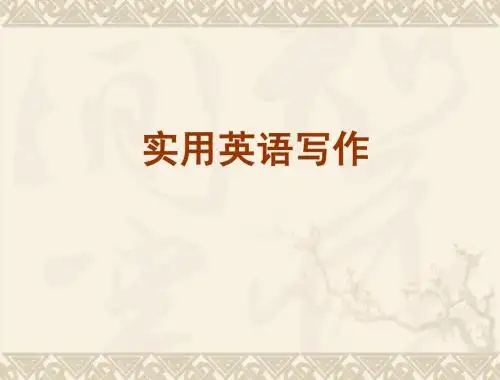
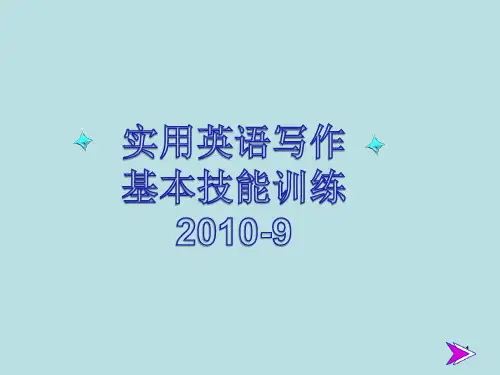
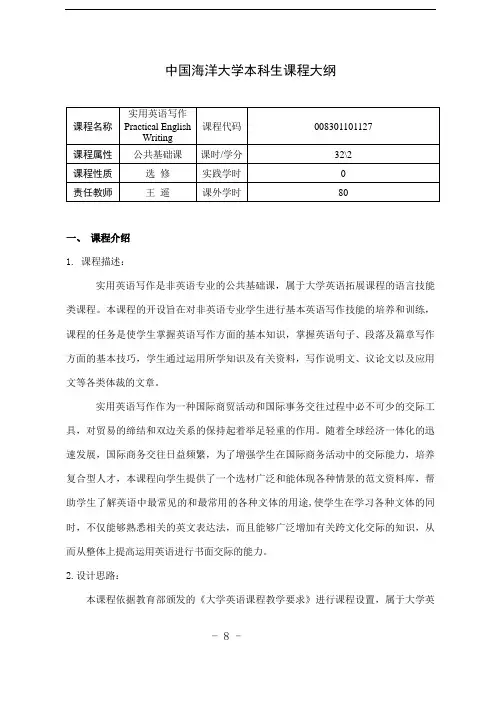
中国海洋大学本科生课程大纲一、课程介绍1.课程描述:实用英语写作是非英语专业的公共基础课,属于大学英语拓展课程的语言技能类课程。
本课程的开设旨在对非英语专业学生进行基本英语写作技能的培养和训练,课程的任务是使学生掌握英语写作方面的基本知识,掌握英语句子、段落及篇章写作方面的基本技巧,学生通过运用所学知识及有关资料,写作说明文、议论文以及应用文等各类体裁的文章。
实用英语写作作为一种国际商贸活动和国际事务交往过程中必不可少的交际工具,对贸易的缔结和双边关系的保持起着举足轻重的作用。
随着全球经济一体化的迅速发展,国际商务交往日益频繁,为了增强学生在国际商务活动中的交际能力,培养复合型人才,本课程向学生提供了一个选材广泛和能体现各种情景的范文资料库,帮助学生了解英语中最常见的和最常用的各种文体的用途,使学生在学习各种文体的同时,不仅能够熟悉相关的英文表达法,而且能够广泛增加有关跨文化交际的知识,从而从整体上提高运用英语进行书面交际的能力。
2.设计思路:本课程依据教育部颁发的《大学英语课程教学要求》进行课程设置,属于大学英- 8 -语的拓展课程系列。
学生顺序修读完大学英语基础阶段的课程后,在听力理解、口语表达和阅读理解等方面已经达到一般要求的英语能力,并能够在认知的基础上学会熟练运用英语,然后可根据自身情况选修本课程。
本课程拟系统全面地讲述了英语写作方面的基本知识和基本技巧。
文稿格式部分简介文稿的安排、移行;字母的大写;标点的基本用法。
措辞部分讨论词的类型:正式、非正式、俚语、地方语、口语、术语;词的本义和引申义;一般和特殊、抽象和具体的词汇;习语;英语中主要的修辞手法。
句子部分包括完整句和不完整句;句子的类型;句子的统一、连贯、简洁、直接、强调、多样化;句式变换。
完整作文部分包括:写作步骤;组织结构;文章体裁。
3. 课程与其他课程的关系:实用英语写作为大学英语拓展课程系列的语言技能课程。
学生顺序修读完大学英语基础阶段的课程后方可进行本课程的学习。
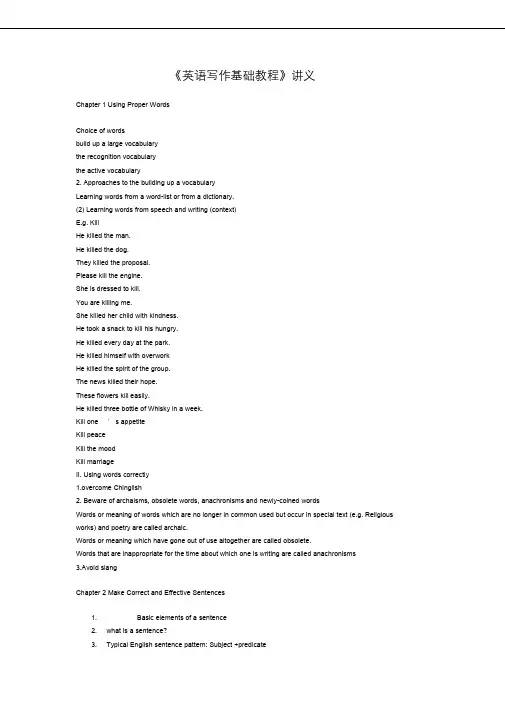
《英语写作基础教程》讲义Chapter 1 Using Proper WordsChoice of wordsbuild up a large vocabularythe recognition vocabularythe active vocabulary2. Approaches to the building up a vocabularyLearning words from a word-list or from a dictionary.(2) Learning words from speech and writing (context)E.g. KillHe killed the man.He killed the dog.They killed the proposal.Please kill the engine.She is dressed to kill.You are killing me.She killed her child with kindness.He took a snack to kill his hungry.He killed every day at the park.He killed himself with overworkHe killed the spirit of the group.The news killed their hope.These flowers kill easily.He killed three bottle of Whisky in a week.Kill one ’s appetiteKill peaceKill the moodKill marriageII. Using words correctly1.overcome Chinglish2. Beware of archaisms, obsolete words, anachronisms and newly-coined wordsWords or meaning of words which are no longer in common used but occur in special text (e.g. Religious works) and poetry are called archaic.Words or meaning which have gone out of use altogether are called obsolete.Words that are inappropriate for the time about which one is writing are called anachronisms3.Avoid slangChapter 2 Make Correct and Effective Sentences1. Basic elements of a sentence2. what is a sentence?3. Typical English sentence pattern: Subject +predicateCoach Dietz exemplified this behavior by walking offthe field in the middle of a game , l eaving her team ata time when we needed her.I need to find a new roommate. I need to find a new roommatehave now isn't working out too well have now isn't working out too well.Well done! What a day!George in Beijing ? Susan a singer?To return from our digressionA run-on sentence consists of two or moresentence —or a semicolon.)Comma splices join two complete sentences with a comma.”and “he needed to buy eggs for Joey went to the grocery store, for he needed to buy eggs for supper.3. The position of modifiers(2) Reference of person(3) Vague ComparisonIV. Coherence(5) The balanced sentenceVI. The kinds of sentencesIn structure: (1) a simple sentence(2) a compound sentence(3) a complex sentence(4) exclamatoryRhetorically:Loose SentencePeriodic sentenceThe balance sentenceThe cumulative sentenceThe anticlimactic sentenceRhetorical questionA. Declarative, Interrogative, Imperative and Exclamatory SentencesAccording to their use, sentences are declarative, interrogative, imperative or exclamatory. A declarative sentence makes an assertion or a statement. An interrogative sentence asks a question. An imperative sentence expresses a command or a request. An exclamatory sentence expresses a strong feeling or emotion, such as surprise, pain, or joy.B. Simple, Compound, Complex, and Compound-Complex SentencesAccording to their structure, sentences are simple, compound, complex, or compound-complex.SIMPLE SENTENCEA simple sentence has only one subject and one predicate-verb, but it may contain more than one object, attribute or adverb. Short simple sentences are usually emphatic; they have special clarity and provide variety when used with longer sentences.e.g. 1. He is a good student.2. Would you tell the way to the Astor Hotel?3. Do not disturb your brother!4. When did you join the club?5. What a lovely girl she is!COMPOUND SENTENCEA compound sentence consists of two or more independent clauses (or simple sentences) related toeach other in meaning, and linked by a coordinating conjunction (and, but, or, so, for, etc.) or by a semicolon without a conjunction. Coordinated ideas should be compatible and roughly equal in importance, or take shape one by one in orderly sequence.e.g. 1. The heavy rain started suddenly, so we stopped planting the trees.2. Jack wanted to go swimming, but his wife wanted to go shopping.3. Her son studies History; her daughter majors in Chemistry.COMPLEX SENTENCEA complex sentence contains one main (or principal) clause and one or more dependent (or subordinate) clauses, with a connective word denoting the relation between the two parts. The dependent clause mayplay the part of a subject, an object, a predicative, an attribute, or an adverbial in the main clause. As arule, the major idea is expressed in the main clause and the idea or ideas of lesser importance in the subordinate clauses.e.g. 1. The government banned the high-blood-pressure pills because they produced side effects.2. Although the shop advertised same-day service, my car was not ready for three days.3. These apple trees, which my father planted three years ago, have not borne any fruit.COMPOUND-COMPLEX SENTENCEA compound-complex sentence contains at least two main clauses and at least one dependentclause —a combination of a compound and a complex sentence.e.g. 1. After I returned to school following a long illness, the math teacher gave me make-up work, but the history teacher made me drop her course.2. When the power line snapped, Tom was listening to the stereo, and Teresa was reading in bed.3. Lisa disliked walking home from the bus stop, because the street had no overhead light and it was lined with abandoned buildings.C. Loose and Periodic SentencesA loose sentence puts the main idea before all supplementary information; in other words, it puts first things first, and lets the reader know what it is mainly about when he has read the first few words. The reverse arrangement makes a periodic sentence: the main idea is expressed at or near the end of it, and it is not grammatically complete until the end is reached. The reader does not know what it is mainly about until he finishes reading it.Compare:1. She was offered a professional contract after winning the Olympic gold medal for figure skating, according to newspaper reports.2. According to newspaper reports, after winning the Olympic gold medal for figure skating, she was offered a professional contract.The main idea of both sentences is the fact that she was offered a professional contract. This idea is put at the beginning of the first sentence and at the end of the second, thus making one a loose sentence and the other a periodic one. Besides, the first part of the first sentence is complete in structure, but that of the second are only prepositional phrases and cannot be called a sentence without the second part. Loose sentences are easier, simpler, more natural and direct; periodic sentences are more complex, emphatic, formal, or literary.D. Short and Long SentencesShort sentences are usually emphatic, whereas long sentences are capable of expressing complex ideas with precision, because it may contain many modifiers. Short sentences are suitable for the presentation of important facts and ideas, and long sentences for the explanation of views and theories, or the description of things with many details.The following passage, which describes how a man saved a drowning girl, makes good use of short sentences.He crouched a little, spreading his hand under the water and moving them round, trying to feel for her. The dead cold pond swayed upon his chest. He moved again, a little deeper, and again, with his hands underneath, he felt all around under the water. And he touched her clothing. But it evaded his fingers. He made a desperate effort to grasp it ⋯He laid her down on the bank. She was quite unconscious and running with water. He made the watercome from her mouth, he worked to restore her. He did not have to work very long before he could feelthe breathing begin again in her; she was breathing naturally. He worked a little longer. He could feel herlive beneath his hands; she was coming back. He wiped her face, wrapped her in his overcoat, lookedround into the dim, dark gray world, then lift her and staggered down the bank and across the fields.---D. H. LawrenceIn contrast to short sentences, long sentences are particularly useful for presenting a set of complex,interlocking ideas. They are common in legal, political and theoretical writing, which depends onmodification for accuracy. In fiction long sentences are sometimes used to describe a person, a thing or ascene.Mrs. Chalmers was kind of fat and her hair was pretty blond and her complexion was soft and pink andshe always looked as though she had been in the beauty parlor all afternoon. She always said “My, you’re getting to be a big boy ”to Peter when she met him in the elevator, in a soft voice, as though shewas just about to laugh. She must have said that fifty times by now. She had a good, strong smell ofperfume on her all the time, too.Mr. Chalmers wore pince-nez glasses most of the time and he was getting bald and he worked late at hisoffice a good many evenings of the week. When he met Peter in the elevator he would say, “It ’s getting colder, ”or “It ’s getting warmer, ”and that was all, so Peter had no opinion about him, except that helooked like the principal of a school.But now Mrs. Chalmers was on her knees in the vestibule and her dress was torn and she was crying andthere were black streaks on her cheeks and she didn ’t look as though she ’d just come from the beauty parlor. And Mr. Chalmers wasn ’t wearing a jacket and he didn ’t have his glasses on and whaht a h d a i r hewas mussed all over his head and he was leaning against the Early American wallpaper making thisanimal noise, and he had a big, heavy pistol in his hand and he was pointing it right at Mrs. Chalmers.---Irwin ShawAlthough series of short and long sentences can both be effective in individual situations, frequentalternation in sentence length characterize much memorable writing. After one or more long sentencesthat express complex ideas or images, the pitch of a short sentence can be refreshing. Look at thefollowing example:We are now so easily misled by vision. Most of the things before our eyes are plainly there, notmistakable for other things except for the illusions created by professional magicians and, sometimes,the look of the light of downtown New York against a sky so black as to make it seem a near view ofeternity. Our eyes are not easy to fool.Similarly, a long sentence that follows a series of short ones can serve as a climax or summing-up thatrelaxes the tension or fulfills that expectation created by the series, giving readers a sense of completion.Here is a good example:We now have, as a result of modern means of communication, hundreds of words flung at us daily. Weare constantly being talked at, by teachers, preachers, salesmen, public officials, and motion-picturesound tracks. The cries of advertisers pursue us into our very home, thanks to the TV —and in somehouses the TV is never turned off from morning to night. Daily the newsboy brings us, in large cities, from thirty to fifty enormous pages of print, and almost three times that amount on Sunday. We go out and get more words at bookstores and libraries. Words fill our lives.VII. sentence varietyChapter 3 Developing ParagraphsChapter 3 Developing Paragraphs1. Basic structure of paragraphsTopic sentence:It states the main idea of the paragraph. It not only names the topic of the paragraph, but it also limits the topic to one or two areas that can be discussed completely in the space of a single paragraph. The specific area is called the Controlling idea.Supporting sentences:It develops the topic sentence. That is, they explain the topic sentence by giving reasons. Some of the supporting sentences that explain the topic sentences about gold are.Concluding sentence:It signals the end of the paragraph and leaves the reader with important point to remember.E.g.There are three reasons why Canada is one of the best countries in the world. First, Canada has an excellent health care system. All Canadians have access to medical services at a reasonable price. Second, Canada has a high standard of education. Students are taught by well-trained teachers and are encouraged to continue studying at university. Finally, Canada's cities are clean and efficiently managed. Canadian cities have many parks and lots of space for people to live. As a result, Canada is a desirable place to live.What is the topic sentence?The topic sentence is the first sentence in a paragraph.What does it do?It introduces the main idea of the paragraph.How do I write one?Summarize the main idea of your paragraph. Indicate to the reader what your paragraph will be about. What are supporting sentences?They come after the topic sentence, making up the body of a paragraph.What do they do?They give details to develop and support the main idea of the paragraph.How do I write them?You should give supporting facts, details, and examples.What is the closing sentence?The closing sentence is the last sentence in a paragraph.What does it do?It restates the main idea of your paragraph.How do I write one?Restate the main idea of the paragraph using different words.Write a paragraph describing what a polar bear looks like.above shapebesideDifferencesSimilaritiesThe following words can help you to write a good sequence paragraph. Helper Words:subsequentlyChoice ParagraphThe following words can help you to write a good choice paragraph: Helper Words:The following words can help you to write a good explanation paragraph: Helper Words:consequentlyhenceChapter 4 Summarizingserve as a model for how you divide and write the essay.Have I rephrased the authorweaknesses? Why? What did the author do well? Not well? Why? II. Requirements for summary writingomitting the detailsreducing the examplessimplifying the descriptionseliminating all repetitionmaking phrases do the work of clauses or sentencesusing general words instead of specific wordsusing the shortest possible transitionsavoiding figurative language3. revisionConclusionA summary is a shortened version of someone else's writing or thoughts.Summaries vary in length and amount of details depending on a teacher's requirements, the length of the original source (article, book, passage) and the purpose of the summary; however, all summaries must: ·be shorter than the original source (article, book, passage) approximately one third the length of the original source;·include the main idea of the original source in your own words;·include major details (also known as supporting ideas) in your own words;·should not include your knowledge, ideas or opinion unless your teacher requests it.·identify the author, title of article, title of publication, where published, publisher, year of publication, and page information, at the top of the page of your summary (or in-text.)Chapter 5 Essay WritingChapter 5 Essay WritingBasic OrganizationIntroduction (beginning)Body (middle)Conclusion (end)Introduction ParagraphWhat is an introduction paragraph?The introduction paragraph is the first paragraph of your essay.What does it do?It introduces the main idea of your essay. A good opening paragraph captures the interest of your reader and tells why your topic is important.How do I write one?1. Write the thesis statement. The main idea of the essay is stated in a single sentence called the thesis statement. You must limit your entire essay to the topic you have introduced in your thesis statement.2. Provide some background information about your topic. You can use interesting facts, quotations, or definitions of important terms you will use later in the essay.Example:Hockey has been a part of life in Canada for over 120 years. It has evolved into an extremely popular sport watched and played by millions of Canadians. The game has gone through several changes since hockey was first played in Canada.Supporting ParagraphsWhat are supporting paragraphs?Supporting paragraphs make up the main body of your essay.What do they do?They develop the main idea of your essay.How do I write them?1. List the points that develop the main idea of your essay.2. Place each supporting point in its own paragraph.3. Develop each supporting point with facts, details, and examples.To connect your supporting paragraphs, you should use special transition words. Transition words link your paragraphs together and make your essay easier to read. Use them at the beginning and end of your paragraphs.Summary ParagraphWhat is a summary paragraph?The summary paragraph comes at the end of your essay after you have finished developing your ideas. The summary paragraph is often called a "conclusion."What does it do?It summarizes or restates the main idea of the essay. You want to leave the reader with a sense that your essay is complete.How do I write one?1. Restate the strongest points of your essay that support your main idea.2. Conclude your essay by restating the main idea in different words.3. Give your personal opinion or suggest a plan for action.Example:Overall, the changes that occurred in hockey have helped to improve the game. Hockey is faster and more exciting as a result of changes in the past 120 years. For these reasons, modern hockey is a better game than hockey in the 1890s.II. Steps Essay writingPrewriting EssaysWhat is the prewriting stage?The prewriting stage is when you prepare your ideas for your essay before you begin writing. You will find it easier to write your essay if you build an outline first, especially when you are writing longer assignments.Six Prewriting Steps:1. Think carefully about what you are going to write. Ask yourself: What question am I going to answer in this paragraph or essay? How can I best answer this question? What is the most important part of my answer? How can I make an introductory sentence (or thesis statement) from the most important part of my answer? What facts or ideas can I use to support my introductory sentence? How can I make this paragraph or essay interesting? Do I need more facts on this topic? Where can I find more facts on this topic?2. Open your notebook. Write out your answers to the above questions. You do not need to spend a lot of time doing this; just write enough to help you remember why and how you are going to write your paragraph or essay.3. Collect facts related to your paragraph or essay topic. Look for and write down facts that will help youto answer your question. Timesaving hint: make sure the facts you are writing are related to the exact question you are going to answer in your paragraph or essay.4. Write down your own ideas. Ask yourself: What else do I want to say about this topic? Why should people be interested in this topic? Why is this topic important?5. Find the main idea of your paragraph or essay. Choose the most important point you are going to present. If you cannot decide which point is the most important, just choose one point and stick to it throughout your paragraph or essay.6. Organize your facts and ideas in a way that develops your main idea. Once you have chosen the most important point of your paragraph or essay, you must find the best way to tell your reader about it. Look at the facts you have written. Look at your own ideas on the topic. Decide which facts and ideas will best support the main idea of your essay. Once you have chosen the facts and ideas you plan to use, ask yourself which order to put them in the essay. Write down your own note set that you can use to guide yourself as you write your essay.Writing EssaysWhat is the writing stage?The writing stage is when you turn your ideas into sentences.Five Writing Steps:1. For the introduction, write the thesis statement and give some background information.2. Develop each supporting paragraph and make sure to follow the correct paragraph format.3. Write clear and simple sentences to express your meaning.4. Focus on the main idea of your essay.5. Use a dictionary to help you find additional words to express your meaning.Editing EssaysWhat is the editing stage?The editing stage is when you check your essay for mistakes and correct them.Editing Steps:Grammar and Spelling1. Check your spelling.2. Check your grammar.3. Read your essay again.4. Make sure each sentence has a subject.5. Make sure your subjects and verbs agree with each other.6. Check the verb tenses of each sentence.7. Make sure that each sentence makes sense.Style and Organization1. Make sure your essay has an introduction, supporting paragraphs, and a summary paragraph.2. Check that you have a thesis statement that identifies the main idea of the essay.3. Check that all your paragraphs follow the proper paragraph format.4. See if your essay is interesting.Publishing EssaysWhat is the publishing stage?The publishing stage is when you produce a final copy of your essay to hand in.Publishing Steps:1. Make a paper copy of your essay.2. Show your work to your teacher, tutor, or parents.3. Ask them for hints on how to improve your writingIII. Types of outlinesThe outline quickly and clearly shares your content and thesis with the reader. In the early stages of your research, an outline will help you to organize your ideas and material. Later in the research process, a more detailed outline will help you unify and refine your final paper. Whether formal or informal in style, outlines aid clear thinking and well-developed ideas.The most important rule for outlining form is to be consistent!An outline can use topic or sentence structure.A topic outline uses words or phrases for all entries and uses no punctuation after entries. Advantages: presents a brief overview of work and is generally easier and faster to write than a sentence outline.A sentence outline uses complete sentences for all entries and uses correct punctuation. Advantages: presents a more detailed overview of work including possible topic sentences and is easier and faster for writing the final paper.You should start your outline by identifying your thesis statement. Then you clarify the progression of your argument as follows:I. Use Roman Numerals to identify the section of your paper. (e.g. Arguments for, Arguments against, background information, biographical information, Evaluation, etc)A. Use Capital letters under each Roman Numeral (Be sure to indent!) to present your arguments within those sections. (e.g. under a paper section called "Advantages of studying at ISP" you may have international community, International Baccalaureate, competitive education).1. Use numbers to list the details or facts that you will use to back up the claims made by the Capital letters.Sample outlineThesis: The war on drugs will do far more to control and eliminate illegal drug use in the USA than will the legalization of drugs.I. Epidemic proportions of drug problem in last decade have prompted efforts at all levels of society to address problemA. Three pronged effort of President's war on drugs - overview1. enforcement2. education3. treatmentB. Legalization also proposed by many as solution - overview of sketchy implementation planII. Arguments in favor of legalizationA. Takes away criminal element1. citation of Amsterdam experiment - Goldblatt2. analogy to legalized prostitution in Europe, NevadaB. Government can control drug quality and quantity1. FDA supervision2. more personnel and support requiredC. More revenue to support prevention and education1. estimates of revenue by Scheffer study2. analogy to revenue from state liquor operations - Maine, OklahomaIII. Arguments against legalizationA. Violates moral/ethical principles of country1. Taber's assessment of constitutional intention2. Heritage Foundation studyB. Makes drugs permanent fixture of society1. analogy to prostitution - Rosenburg study2. normalization lowers standards - Whitten's studyC. Encourages greater drug use by wider spectrum of users1. Post Vietnam study of mid size American cities2. Impact on middle class and youth - Fallow's viewsD. Subsidizes addiction with public money1. Amsterdam argument - Goldblatt's rebuttalE. Does not address causes of addiction - inner city survey from 1996IV. Three pronged war on drugs addresses supply, prevention, treatmentA. Coordinated law enforcement efforts at local, state, federal levels1. Legislative intent - McMurphy Bill2. sample cases from PA, MA, DC, CAB. Education - treatment programs at state - local levels1. success of NA based programs2. statistics on welfare cost saving3. 1997 Florida based studyC. Attention to factors encouraging drug dealing - addiction1. poverty and lack of education - Wilson data2. low self-esteem, lack of hope - AMA's new policy initiative3. lack of community involvement with youth - Center for Urban Studies position paperV. War on drugs clearly better than legalizationA. War on drugs is long range solutionB. War on drugs addresses underlying causesC. War on drugs consistent with country's valuesD. War on drugs will eventually end widespread drug useIV. Types of WritingNarrationNarration1. What is narration?The method of development in which the writer tells a story to support a point. Narrative writing tells a story. In essays the narrative writing could also be considered reflection or an exploration of the author's values told as a story. The author may remember his or her past, or a memorable person or event from that past, or even observe the present.2.Essential Featuresa. Context--the writer makes clear what happened, when, where, and to whom1.) There is a plot that involves escalating conflict between characters, between a person andher-/himself, or between people and nature or some other force.2.) The conflict sets up an imbalance, a tension that a reader wants resolved, and that finally is.3.) The setting places the events in a definite time period and particular location4.) The events happen to a combination of round characters, the best of whom perform in ways that are unpredictable, yet ultimately consistent with their own individual personalities and motivations, and lesser personages.b. Point of view--the writer takes a consistent point of view in relation to the action, writing either as a participant (first person -- using "I") or as a spectator (third person -- using "he," "she," "it," "they").c. Selection of detail--the writer focuses only on the actions and details that further the story and promote the point, minimizing or eliminating others.1.) Expression of feelings2.) Dialogue--direct quotes of what the characters say to each otherd. Organization--the writer organizes the events of the story in a chronological order using time transitions.e. Purpose —there's a reason for telling the story. One way to find it is to complete the statement, "The moral of the story is..."2. Why do writers use narration?a. To entertainb. To reportc. To instructUltimate goal: to tell an entertaining story yet also bring readers to a clear understanding of a larger issue.3. How can readers and writers tell narration from the other MODs? They can ask:a. Does something happen between people and people or people and outside forces? What happens?b. Where is the tension?c. How is the conflict resolved?d. Do characters dialogue with each other? Are there direct quotations?e. What kinds of feelings are brought out?f. What is "the moral of the story?"The more of these items which appear, the more likely it is narration.4. How does one write essays with it?a. Determine an audience and purpose in telling the story--a broad instructive point it may make about human nature or the ways of the world. Who needs to have this information in order to have a more satisfying life?Determining the audience and purpose helps the writer select details and events.It also keeps him/her from wasting time developing a pointless essay.b. Context —Establish the setting of the essay, the world in which the action takes place, in the first paragraph or two.Give the characters real names and include a capsule portrait of each--a one or two sentences or phrases that captures the personalities of the main ones.State where the events take place using place names that could be found in an atlas, and/or describing items such that Spielberg's set dresser wouldn't have much trouble knowing what to get or where to put them.Use time indicators: breakfast, afternoon tea, midnight, sunrise, almost noon, first, then, next. . .c. Keep a consistent point of view throughout the essay, writing either in the first or third person throughout. Eliminate any "you" or "your" that creeps into a sentence by revising it.d. Select details and events that serve a worthwhile purpose, but not so much that there is an excess of information that is ultimately boring.。
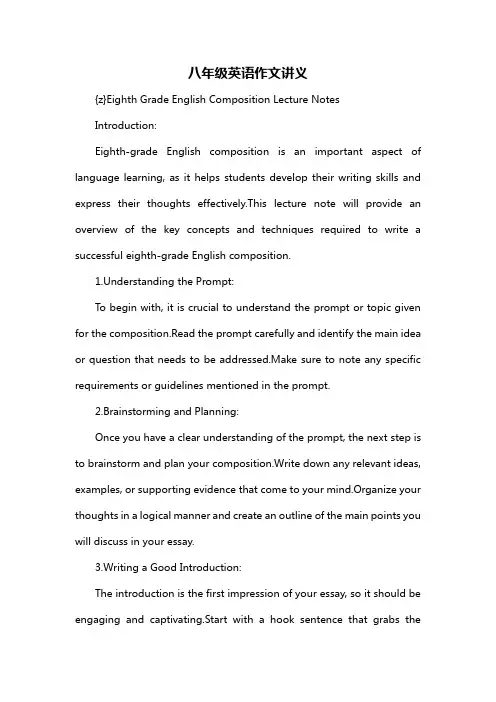
八年级英语作文讲义{z}Eighth Grade English Composition Lecture NotesIntroduction:Eighth-grade English composition is an important aspect of language learning, as it helps students develop their writing skills and express their thoughts effectively.This lecture note will provide an overview of the key concepts and techniques required to write a successful eighth-grade English composition.1.Understanding the Prompt:To begin with, it is crucial to understand the prompt or topic given for the composition.Read the prompt carefully and identify the main idea or question that needs to be addressed.Make sure to note any specific requirements or guidelines mentioned in the prompt.2.Brainstorming and Planning:Once you have a clear understanding of the prompt, the next step is to brainstorm and plan your composition.Write down any relevant ideas, examples, or supporting evidence that come to your anize your thoughts in a logical manner and create an outline of the main points you will discuss in your essay.3.Writing a Good Introduction:The introduction is the first impression of your essay, so it should be engaging and captivating.Start with a hook sentence that grabs thereader"s attention.Introduce the main idea of your essay and provide a brief overview of what the reader can expect to learn from your composition.4.Developing the Body Paragraphs:The body paragraphs are the main part of your essay, where you present your arguments and evidence.Each paragraph should have a clear topic sentence that states the main idea of the paragraph.Support your topic sentence with relevant details, examples, or quotes from the e transitional words and phrases to connect your ideas and make the essay flow smoothly.5.Writing a Conclusion:The conclusion is the final part of your essay, where you summarize the main points discussed in the body paragraphs.Restate the thesis statement in a slightly different way and remind the reader of the importance of your topic.End with a strong closing sentence that leavesa lasting impression.6.Editing and Proofreading:Once you have written your essay, it is essential to edit and proofread it for any errors or mistakes.Check for spelling, grammar, punctuation, and sentence structure errors.Make sure your essay is well-organized and coherent.It is also a good idea to have someone else read your essay and provide feedback.Conclusion:Writing a successful eighth-grade English composition requires practice, planning, and attention to detail.By following the steps outlined in this lecture note, you can improve your writing skills and produce compelling essays.Remember to read the prompt carefully, brainstorm and plan your composition, write a good introduction, develop the body paragraphs, write a strong conclusion, and edit and proofread your essay.Good luck!。
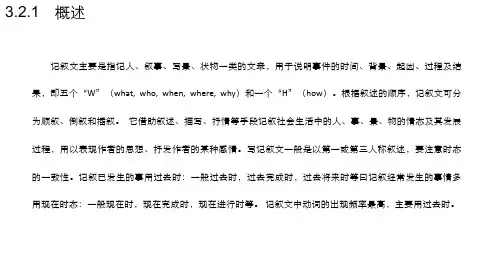
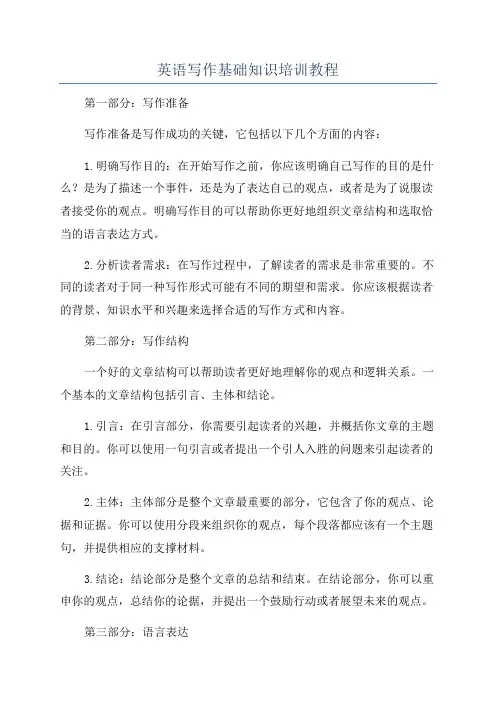
英语写作基础知识培训教程第一部分:写作准备写作准备是写作成功的关键,它包括以下几个方面的内容:1.明确写作目的:在开始写作之前,你应该明确自己写作的目的是什么?是为了描述一个事件,还是为了表达自己的观点,或者是为了说服读者接受你的观点。
明确写作目的可以帮助你更好地组织文章结构和选取恰当的语言表达方式。
2.分析读者需求:在写作过程中,了解读者的需求是非常重要的。
不同的读者对于同一种写作形式可能有不同的期望和需求。
你应该根据读者的背景、知识水平和兴趣来选择合适的写作方式和内容。
第二部分:写作结构一个好的文章结构可以帮助读者更好地理解你的观点和逻辑关系。
一个基本的文章结构包括引言、主体和结论。
1.引言:在引言部分,你需要引起读者的兴趣,并概括你文章的主题和目的。
你可以使用一句引言或者提出一个引人入胜的问题来引起读者的关注。
2.主体:主体部分是整个文章最重要的部分,它包含了你的观点、论据和证据。
你可以使用分段来组织你的观点,每个段落都应该有一个主题句,并提供相应的支撑材料。
3.结论:结论部分是整个文章的总结和结束。
在结论部分,你可以重申你的观点,总结你的论据,并提出一个鼓励行动或者展望未来的观点。
第三部分:语言表达语言表达是写作中十分重要的一部分,它可以帮助你更好地传达你的意思和观点。
1.使用简洁明了的语言:避免使用过于复杂的词汇和长句子,尽量使用简洁明了的语言来表达你的思想。
同时,也要注意使用正确的语法和标点符号。
2.使用多样化的句子结构:使用多样化的句子结构可以增加文章的可读性和吸引力。
你可以使用简单句、复合句和复合复合句等不同的句子结构来表达不同的意思。
3.使用恰当的过渡词:过渡词可以帮助你更好地组织文章结构和表达逻辑关系。
例如,同时,然而,因此等过渡词可以帮助你连接不同的观点和段落。
4.避免口语化表达:在正式的写作中,避免使用口语化的表达方式,例如,缩写、口头禅和非正式的词汇。
尽量使用正式的、准确的语言表达方式来提高你文章的可信度。

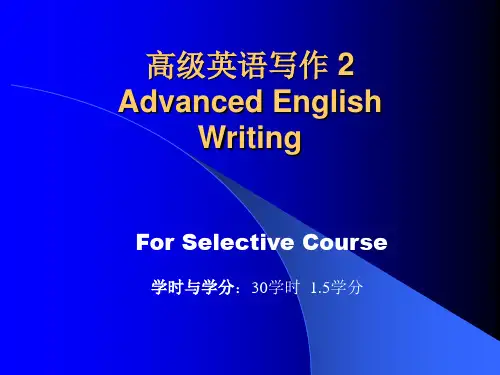
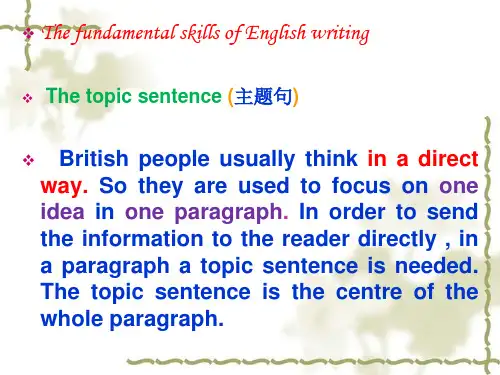
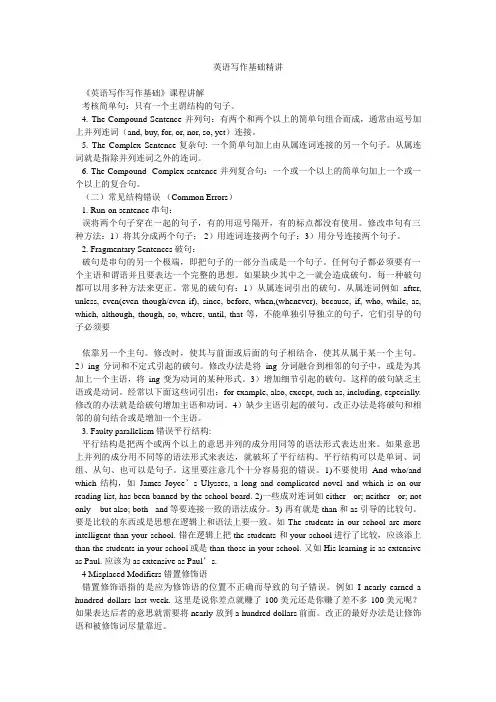
《实用英语写作》教学大纲Practical English Writing课程编码:08A11290 学分:2.0课程类别:专业任选课计划学时:32 其中讲课:32 实验或实践:0 上机:0适用专业:英语推荐教材:丁往道、吴冰.英语写作手册(英文版第三版) [M].北京:外语教学与研究出版社,2009.参考书目:1. 冯秀红.实用英语写作[M].南京:东南大学出版社. 2008.2. 田力平.实用英语写作[M].北京:北京邮电大学出版社有限公司. 2012.3. 周邦友.英语应用文写作(第四版)[M].上海:东华大学出版社, 2015.课程的教学目的与任务《实用英语写作》是英语专业的一门专业任选课,本课程旨在帮助学生熟悉各种常见英语应用文体,掌握常见英语应用文的写作方法,提高学生英语应用文的写作技能,能在实际工作中灵活运用所学知识,为今后走向工作岗位打下良好的英语应用文写作基础。
课程的基本要求1. 通过本课程学习,学生应掌握常用英语应用文的用途及基本格式、写作特点以及相关的常用句型或词汇。
2. 通过学习和实践,能够运用英语熟练地写作专用书信、求职应用文、便条、备忘录、启事以及通知等各种应用文,做到格式规范、条理清晰、内容充实、语言通顺、用词得当。
3. 进一步提高书面表达能力和综合运用英语能力。
各章节授课内容、教学方法及学时分配建议本课程采用课堂讲授和写作实践相结合的教学方式。
课堂讲授使用多媒体教学,由教师讲解写作技巧并引导学生发现使用规律,结合小组活动和个人训练等各种形式提高学生的写作学习热情。
强调写作过程的教学,积极鼓励学生参与课堂教学,培养学生获取和运用知识的能力、分析问题的能力、独立提出见解的能力和创新的能力。
在课外布置适量的写作任务,及时操练和巩固所学的语言知识和写作技巧,加强对语言的实际运用能力。
第一章:General Remarks on Practical English Writing 建议学时:4[教学目的与要求] Learn about the importance, the characteristics and principles of practical English writing.[教学重点与难点] Characteristics and principles of practical English writing.[授课方法] Take the approach of lecture combined with personal writing practice and group work; Traditional teaching approach combined with modern teaching facility—Computer Assisted Instruction (CAI)[授课内容]第一节Importance of practical English writing第二节Characteristics of practical English writing第三节Principles of practical English writing第四节Rudimentary knowledge of practical English writing 第二章:Social Correspondence 建议学时:6[教学目的与要求] Grasp writing of social correspondence.[教学重点与难点] structure of a letter; Characteristics of personal letters and social letters[授课方法] Take the approach of lecture combined with personal writing practice and group work;Traditional teaching approach combined with modern teaching facility—Computer Assisted Instruction (CAI)[授课内容]第一节structure of a letter第二节how to write personal Letters第三节how to write social Letters第三章:Business Letters 建议学时:6[教学目的与要求] Grasp the characteristics of business letters. Learn to write the appropriate business letters.[教学重点与难点] Structure and Style of Business Letters[授课方法] Take the approach of lecture combined with personal writing practice and group work; Traditional teaching approach combined with modern teaching facility—Computer Assisted Instruction (CAI)[授课内容]第一节Structure and Style of Business Letters第二节Samples of General Business Letters第三节Business terms, common words and expressions in business letters第四章:Personal and Public Information建议学时:8[教学目的与要求] Learn how to offer personal and public information.[教学重点与难点] the writing of resume, application letters, notice and news announcement.[授课方法] Take the approach of lecture combined with personal writing practice and group work; Traditional teaching approach combined with modern teaching facility—Computer Assisted Instruction (CAI)[授课内容]第一节Writing of personal statement and resume第二节Writing of application letters第三节Writing of notice第四节Writing of news announcement第五章:Advertisements 建议学时:4[教学目的与要求] Learn how to write advertisements.[教学重点与难点] structure and stylistic features of advertisements[授课方法] Take the approach of lecture combined with personal writing practice and group work; Traditional teaching approach combined with modern teaching facility—Computer Assisted Instruction (CAI)[授课内容]第一节Writing of merchandise selling advertisements第二节Writing of enrollment Advertisements第三节Writing of employment Advertisements第六章:Research Paper Writing建议学时:4[教学目的与要求] Learn how to write research papers.[教学重点与难点] General format and stylistic features of research papers[授课方法] Take the approach of lecture combined with personal writing practice and group work; Traditional teaching approach combined with modern teaching facility—Computer Assisted Instruction (CAI)[授课内容]第一节Usual steps in writing a research paper第二节Stipulated format of research paper第三节Useful expressions and structures in research paper writing。
本科生课程大纲课程属性:公共基础/通识教育/学科基础/专业知识/工作技能,课程性质:必修、选修一、课程介绍1.课程描述:实用英语写作课程作为英语专业学生的工作技能选修课程,旨在使学生了解必要的写作基础知识和实用文体的写作技巧和方法,通过写作理论知识讲授与写作实践训练相结合,使学生系统掌握英语的句法结构,熟悉英汉思维模式的差异,培养正确的英语表达能力,同时掌握简单的英语文章的写作,了解英语各种文体的表达方式和特点,扩大词汇量和熟悉英语常用句型,提高学生运用英语表达自己思想的能力。
2.设计思路:本课程引导学生了解实用英语写作的基本知识,对比分析英汉两种语言文化特点,培养学生的语感和文化知觉,从而在写作实践中准确、恰当地使用英语表达自己的思想。
课程重点讲授以下几个方面:实用英语写作的基本规律及原则,包括写作格式、思想组织、文章体裁、篇章结构以及常见的应用文的写作方法与技巧,等等。
针对不同文体、不同领域的材料进行讲解和训练,提高学生的语言综合运用能力,有能力完成各类实用文体的写作。
教学方式上,将采取传统讲授、课堂讨论、课后练习相结合的方法,使课堂学习与课外学习有机结合起来。
课堂上教师重点讲授、引导课堂讨论、结合课堂练习和课后作业有针对性的点评和总结,- 1 -充分调动学生课外自主学习的能动性,使两者相得益彰。
本课程需要在多媒体教室上课。
二、课程目标本课程在加强英语语言基础知识和基本技能训练的同时,重视培养学生初步的写作能力,特别是常用应用文的写作能力。
通过学习,学生应达到以下几个要求:1.熟悉各类应用文的书写格式和写作方法;2.能在阅读书面材料时做笔记、回答问题、写提纲和摘要;3.能就一定的话题或提纲、表格或图示,在规定时间内写出一定长度的短文;4.能写信函、便条和简历;5.写作格式正确,表达意思清楚得体,无重大语言错误。
三、学习要求要完成所有的课程任务,学生必须:(1)按时上课,上课认真听讲,积极参与课堂讨论、随堂练习和课后写作任务。